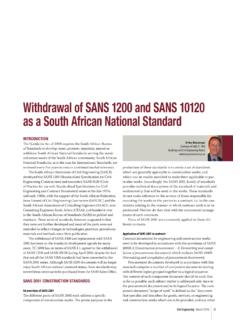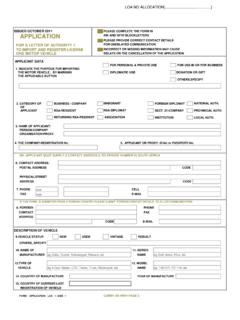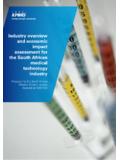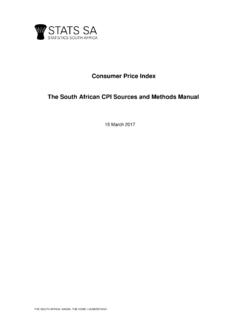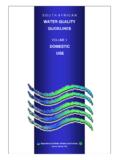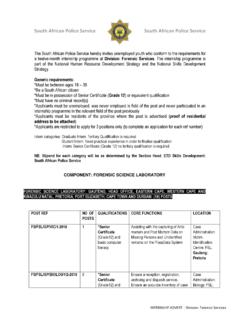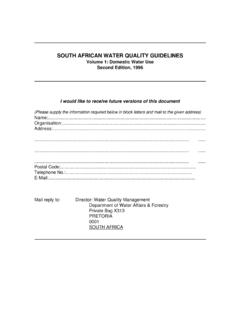Transcription of A Reflection of the South African Maize Meal and …
1 A Reflection of the South African Maize Meal and wheat flour fortification programme (2004 to 2007)A Reflection of the South African Maize Meal and wheat flour fortification programme (2004 to 2007) The Department of Health South Africa and UNICEF South AfricaFooD fortification CoNTACTS:The Department of HealthPrivate Bag X828 Pretoria , 0001 Telephone : 012 312 0062Ms Lynn Moeng, moengl @ Ms Maude de Hoop, dehoom @ Mr Benny Sikhakhane, sikhab @ United Nations Children s FundP O Box 4884 Pretoria , 0001 Telephone : 012 354 8201Dr Ngashi Ngongo, nngongo @ Joan Matji, jmatji @ and layout : Handmade Communications, viv @ 5 and 34, Athol Rheeder; iv, 9, 13, 32 and 41, Department of Health; 10 ; 40 GAIN; 4, 21, 28, 36 and 37, GCIS; 15, 18, 24, 25, 26 , 27 and 35, Giacomo Pirozzi / UNICEF; 42 and 31 Ian Britton / South African Maize MEAL and wheat flour fortification programme (2004 TO 2007)iiiTHE South African Maize MEAL and wheat flour fortification programme (2004 TO 2007)TABLE oF CoNTENTSiiTraining retailers.
2 21 Government structures ..21 Monitoring and testing fortification mix manufacturers/suppliers ..22 Overburdened and under-capacitated laboratories ..23 Social Marketing and Communications ..25 Issues and challenges ..26 programme Management and Administration ..28 Monitoring and Evaluation ..29 PUbLIC -P RI vATE PARTNERSHIPS (PPP) ..31 KEY RESULTS OF THE fortification INITIATIvE ..32 Lessons learned ..32 Communication ..33 Marketing ..33 Support ..33 THE South African FOOD fortification programme : AN EvENING OF Reflection ..34 UNICEF Representative, Mr Macharia Kamau: Talking Points.
3 34 Speech by the Minister of Health, Dr Manto Tshabalala-Msimang ..37 Address presented by Mr Larry Umunna, Regional Representative for Africa, Global Alliance for Improved Nutrition (GAIN), Geneva, Switzerland ..40 LIST OF ACRONYMS ..IvPROJECT PARTNERS AND THEIR CONTRIbUTIONS ..1 INTRODUCTION ..2 Developing a Solution ..4 Packaging ..5 Overcoming initial concerns ..5 Why Are These Nutrients Important? ..6 The Process of Fortifying Food ..7 The Challenge of Food fortification ..8 fortification mix stability ..8 Micronutrient losses ..8 Monitoring ..8bACKGROUND.
4 10 THE FOOD fortification PROJECT ..11 Compliance Monitoring and Enforcement Training ..12 Issues and challenges ..13 Industry concern over the impact of fortification on sales ..13 Distrust and competition between small and large-sized millers ..14 The complexity of finding small millers ..14 Government bureaucracy ..15 Issues and challenges ..19 Shifting the mindset of EHPs ..19 The excessive demands currently placed on EHPs ..20ivTHE South African Maize MEAL and wheat flour fortification programme (2004 TO 2007)1 THE South African Maize MEAL and wheat flour fortification programme (2004 TO 2007)
5 LIST oF ACRoNYMSCDC Centre for Disease Control, AtlantaDBSA Development Bank of Southern AfricaDIT Durban Institute of TechnologyDoH Department of Health DTI Department of Trade and IndustryEHP Environmental Health PractitionerGAIN Global Alliance for Improved NutritionMI Micronutrient InitiativeNAMM National Association of Maize MillersNCM National Chamber of MillingNFA National fortification AllianceNTD Neural Tube DefectsRDA Recommended Dietary AllowanceSABC South African Broadcast CompanySABS South African Bureau of Standards TUT Tshwane University of TechnologyUNICEF United Nations
6 Children s FundPR oJECT PARTNERS AND THEIR CoNTRIBUTIoNSDepartment of Health for the Republic of South Africa (DoH) the lead implementing agency and coordinator of the Alliance for Improved Nutrition (GAIN) funder of the Food fortification programme for the period 2004 to Nation s Children Fund (UNICEF) executing agencyDevelopment Bank of Southern African the fiduciary agent ap-pointed by GAIN for oversight on the fortification Alliance (NFA) alliance coordinating implementation of the Food fortification programme under the leadership of the Department of Health, Nutrition DirectorateThe Micronutrient Initiative initial international funding pro-vider and member of the Chamber of Milling (NCM) representing the milling industry on the National Chamber of Baking representing the baking in-dustry on the University of Technology (TUT)
7 Provider of training to Environmental Health Practitioners, including the creation of the training and mentorship Environmental Health Practitioners in-dividuals responsible for the compliance monitoring and enforce-ment of Consumer Goods Council a consumer rights African Bureau of Standards (SABS) national body re-sponsible for sampling, testing, certifying and monitoring products sold to the South African Maize MEAL and wheat flour fortification programme (2004 TO 2007)3 THE South African Maize MEAL and wheat flour fortification programme (2004 TO 2007)INTRoDUCTIoNA comprehensive study on the nutritional status of pre-school chil-dren supported by the Department of Health (DoH) and pub-lished in 1995 by the South African Vitamin A Consultative Group (SAVACG) showed that one-third of the country s children under six years of age were vitamin A deficient and one-fifth of children were anaemic.
8 Anthropometric measures also showed that million children were stunted; a problem that was particularly evident among children who lived in traditional housing in rural areas and whose mothers had lower levels of education. The study concluded with recom-mendations to the Department of Health to investigate the feasibility of food fortification as a medium-term strategy for improving the vitamin A status of children. Research conducted in 1997 under the auspices of the Health Systems Trust, a South African non-governmental organisation, sup-ported the findings of the 1995 report.
9 Entitled The Nutritional Status of South Africans: A Review of the Literature from 1975-1996, it collated the results from four national studies and several smaller-scale studies to conclude that up to 25% of preschool children and at least 20% of primary school children were stunted from malnutrition. This study also referred to fortification as a possible strategy for improving the intake of essential CERPTS FRoM South African VITAMIN A CoNSULTATIVE GRoUP (SAVACG)(Source : /nutrition ) MAIN FINDINGSF indings on the main objectives :Vitamin A status One in three children had a marginal vitamin A status (serum vitamin A con-centration below 20 _g /dL).
10 Children living in the rural areas and whose moth-ers were poorly educated were the most disadvantaged. According to interna-tional criteria , the national prevalence (33%) of marginal vitamin A status found in this study identif ies the country as having a serious public health problem of vitamin A def iciency. Iron status One in f ive children in the country was anaemic, one in f ifteen moderately anaemic and one in f ive hundred severely anaemic. In terms of iron status, one in ten children was iron depleted or def icient, one in twenty was severely iron depleted or def icient and one in twenty had iron def iciency anaemia.










